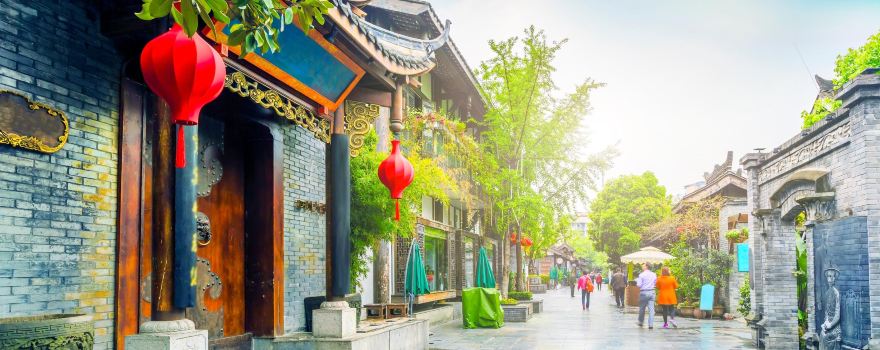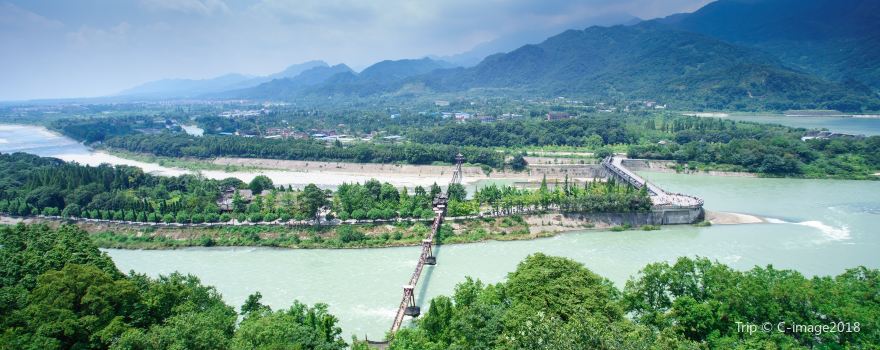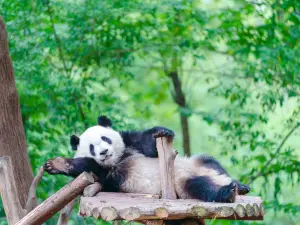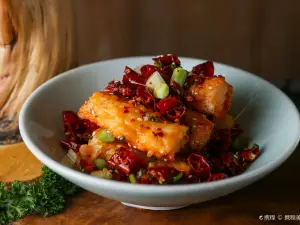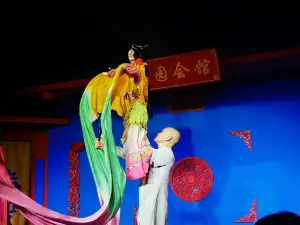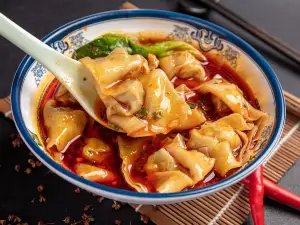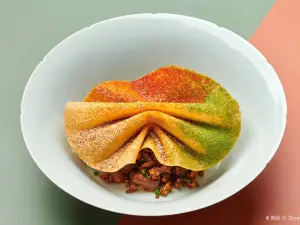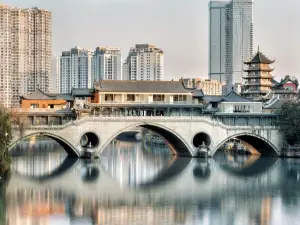Things to Do in Chengdu in 2025 - Top Attractions, Local Food, Hotels & Travel Tips (Updated April 2025) | Trip.com
About Chengdu
Recommended trip: 2–5 day(s)
Recommended trip: 2–5 day(s)Current Weather Conditions
Chengdu Local Experiences Map

Trending in Chengdu
Chengdu Local Travel Guide 2025
Chengdu Brief Guide
Chengdu is a city on the rise, one you will want to visit again and again. Chengdu has a long and storied history. It has a unique cuisine with a huge number of hot and spicy dishes, as well as an enviously relaxed pace of life. Historic Jinli Ancient Steet’s overpowering sense of enthralling antiquity, adorable giant pandas and avenues full of hotpot restaurants all call out to welcome visitors from near and far. On the outskirts of town, you can find quiet solace in peaceful Qingcheng Mountain. It is a vastly different side of Chengdu. Chengdu is also a fashionable city. The nightscape of Jiuyan Bridge and the nearby Kuanzhai Alley truly make people feel the fast-paced pulse of the city.
Chengdu Must-try Local Experiences
1. Meet the Giant Pandas at Chengdu Research Base of Giant Panda Breeding No trip to Chengdu is complete without seeing the adorable giant pandas at the Chengdu Research Base of Giant Panda Breeding. Learn about their behavior, watch them play, and maybe even see a baby panda! 2. Immerse Yourself in Sichuan Opera Experience the vibrant art form of Sichuan Opera with its expressive masks, lively music, and captivating performances at a traditional teahouse. 3. Learn Tea Culture at a Traditional Teahouse Visit a traditional teahouse to experience Chengdu's rich tea culture. Enjoy a cup of jasmine or green tea while watching locals play mahjong or listening to live music. 4. Experience the Spicy Delights of Sichuan Cuisine Indulge in Sichuan cuisine with dishes like Mapo Tofu, Kung Pao Chicken, and Sichuan Hot Pot. Don't miss the chance to try street food like dan dan noodles and spicy rabbit head. 5. Find Treasures at Jinli Ancient Street and Kuanzhai Alley Wander through Jinli Ancient Street and Kuanzhai Alley, filled with traditional architecture, shops, teahouses, and restaurants, perfect for unique gifts. 6. Relax in People's Park People's Park is a popular spot for locals and tourists to enjoy a boat ride, sip tea, or watch locals practice tai chi. 7. Take a Day Trip to the Dujiangyan Irrigation System Visit the ancient Dujiangyan Irrigation System, a UNESCO World Heritage site, to marvel at its ingenious design and historical significance.
Chengdu Must-see Attractions
Chengdu, a city rich in cultural and natural attractions, is home to the Chengdu Research Base of Giant Panda Breeding, the ancient Dujiangyan Irrigation System, the historical Wuhou Shrine, the poetic Chengdu Du Fu Thatched Cottage Museum, and the serene UNESCO World Heritage Site of Qingcheng Mountain, each offering unique insights into China's heritage and natural wonders.
Chengdu Food Guide
Chengdu is renowned for its diverse and flavorful street food, including the spicy and tender Bobo Chicken, the sweet and performative San Da Pao, the culturally symbolic and savory Rabbit Head, the slightly sour and spicy Dan Dan Noodles, and the crispy yet tender Egg-Baked Cake, each offering a unique taste of the city's rich culinary heritage.
Chengdu Transportation
Chengdu's transportation infrastructure is well-developed, with Chengdu Shuangliu International Airport and Chengdu East Railway Station being key hubs for travelers entering and leaving the city. Chengdu Shuangliu International Airport (IATA: CTU) is a significant aviation hub located approximately 16 kilometers southwest of downtown Chengdu. As one of the busiest airports in China, it serves as a core hub for Air China and the main hub for Sichuan Airlines and Chengdu Airlines. To reach the city from Shuangliu Airport, passengers can take the Chengdu Metro Line 10 directly to the city center. Chengdu East Railway Station (Chengdu Dong Kezhan) is a major railway hub situated 9 kilometers southeast of Chengdu downtown. It connects to several high-speed rail lines and is accessible via Chengdu Metro Line 2 and Line 7. This station is a key part of the city's rail network, offering services to various destinations across China.
Chengdu Where to Stay
Chengdu is a city that offers a diverse array of accommodation options, catering to the needs of various travelers. The city's hotels are spread across several key areas, each with its own unique characteristics, ranging from bustling commercial centers to quaint, historic neighborhoods. Visitors can choose from regions that offer proximity to shopping and entertainment, cultural experiences, or serene environments close to nature.
Chengdu Best Time To Visit
The best time to visit Chengdu is during the spring months from March to June and the autumn months from September to November. These periods offer comfortable weather conditions, with mild temperatures and less rainfall, ideal for exploring the city's attractions and witnessing the active behavior of the famous giant pandas. Specifically, the months of March to May are the "falling in love" period for pandas, and visiting between late August and December increases the chances of seeing newborn panda cubs. Autumn also promises fewer crowds and the city's landscapes painted in vibrant colors by the changing leaves.
Chengdu Useful Guide
Chengdu, the capital of Sichuan province, is a linguistic tapestry where Mandarin is the official language. However, the Chengdu-Chongqing dialect, a branch of Southwestern Mandarin, is widely spoken. Translation apps and phrasebooks can aid communication, but expect a charming challenge with the local Sichuanese. Embrace gestures and visual aids like photos to bridge language gaps. Chengdu's multilingualism reflects its cultural depth and rapid economic growth.
Trip.Best: Chengdu
Things to do in Chengdu
What to Do
Chengdu Research Base of Giant Panda Breeding
Liyuan Liyuan Guild Hall-Chuan Opera Changing Face (wenshuyuan store)
Dujiangyan China Giant Panda Garden (formerly known as Panda Paradise)
Where to Stay
What to Eat
The River House Western Restaurant & Lounge
Chengdu Moments: Through Travelers' Eyes
I made a special trip to Chengdu just for a bookstore
Chengdu’s futuristic atmosphere
Dujiangyan Library
Chengdu Must See and Do
Chengdu | Such a stunning bookstore, how can you keep it to yourself?
Zhongshuge Bookstore: A Surreal Literary Oasis in Chengdu
2-Day Chengdu Itinerary: A Perfect Blend of Pandas, History, and Culture
Chengdu: Must visit in China
What People Are Saying About Chengdu
Chengdu Research Base of Giant Panda Breeding
Dujiangyan Scenic Spot
Chengdu Du Fu Thatched Cottage Museum
Wuhou Shrine
Mount Qingcheng
Jinsha Site Museum
Chengdu Museum
Wen Shu Fun
Liyuan Liyuan Guild Hall-Chuan Opera Changing Face (wenshuyuan store)
Shufeng Yayun Sichuan Opera House
Chengdu: FAQ

What's the most popular attractions in Chengdu?

Things to do near Chengdu for family & child?

How to get to Leshan from Chengdu?

How to get to Beihai from Chengdu?

How to get to Jiuzhaigou from Chengdu?

How to get to Sanxingdui from Chengdu?
Best of Chengdu
Site Operator: Trip.com Travel Singapore Pte. Ltd.

